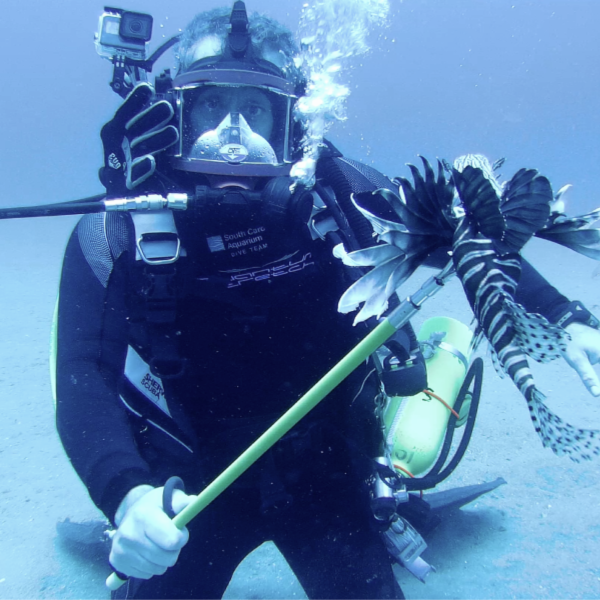With Invasive Species Awareness Week starting today, we could think of no other species to spotlight than the notorious lionfish! Donning a series of spines and a reddish orange striped exterior, some might be surprised to think of these colorful creatures as anything but sweet. Swimming far and wide in the foreign Atlantic (most likely from an accidental release), these invaders reproduce with a vengeance envious of many predators. Unfortunately, they don’t serve as prey for much at all.
You see, lionfish have many biological benefits that make them detrimental to the health and wellbeing of other native marine life, like snapper and grouper species. To begin, lionfish populations can go from a select few to a few thousand pretty quick; once they reach maturity, females release about 50,000 eggs every four days. Their venomous spines surrounding their body act as a shield of armor against others and a strong deterrent from taking a bite. Their stomachs also have the ability to expand 30 times larger than their original size, so they often compete with natives for prey. Add a ravenous appetite to the mix and we’ve got ourselves a recipe of disaster!

Sure, there’s a lot of intense knowledge sharing about this infamous fish, but how do you decipher fact from fiction? Let’s dive in and debunk some of the most common myths associated with lionfish and how you can help.
Lionfish are poisonous.
False! They are venomous, not poisonous, meaning injury is caused by a sting or a bite rather than an ingestion. In the case of lionfish, their sharp spines contain the venom but their body is free of it. Which leads us to the next statement…
You can’t even eat lionfish – it’s not safe, and they’re too small and bony!
Not true! Their venom is contained in their spines, and would cause harm only if going through our bloodstream. Removing the spines during filet preparation helps alleviates the concern. Plus, cooking over high heat would denature the protein in the venom, deeming it harmless.
When it comes to their size, adult lionfish range from 12-18 inches, with a robust body that can make for a hearty meal. Some buzz words describing the taste of lionfish include buttery, tender, flaky and decadent. We might be biased, but that sounds like a good palate pleaser to us!

Removing lionfish won’t make a difference.
Not the case! Conservation matters, and lionfish removal is no exception to that statement. Studies have shown that concentrated lionfish removal (also referred to as lionfish culling) can make a huge difference in rebuilding the population status of some native species. With less lionfish on reefs, that’s one less threat that native species have to overcome in order to reach adulthood.
Here at the Aquarium, our dive team has been actively culling lionfish for years through Reef Research. This offshore, ocean-based program celebrates the importance of marine protected areas (MPAs) for scientific discovery and for sustaining a balanced ocean. In partnership with the South Carolina Department of Natural Resources (SCDNR), we’ve completed a pilot research project at designated MPAs, Areas 51 and 53, made of artificial reefs – the first of their kind in the nation.
For this project, we studied the effects of removing invasive lionfish from the MPAs to determine changes to the abundance and diversity of other species, like snapper and grouper (native species that compete with lionfish for prey). Our research has shown that removing even just a few can help maintain a balanced ecosystem. Though the pilot project for Reef Research concluded, our Aquarium dive team continues to charter out to the MPAs by boat to remove invasive lionfish from our waters.

I don’t dive, so I can’t help.
Yes, you can! Everyone can help, in one way or another:
Share what you’ve learned. Knowledge is truly power, and teaching others about lionfish, their impacts and current solutions can help garner additional support for conservation efforts.
Seek it out on menus, or add it to your own. Lionfish are a great sustainable seafood option, especially here in the southeastern U.S. Ask for it when you go out to eat or when shopping at your local grocery store. Let the food industry know your interest in lionfish, so we can start seeing them less as a chef special and more as a permanent option on menus and fixtures behind food counters.
Follow the science. Stay up-to-date on what organizations are doing to help, and get involved where you feel most comfortable.


